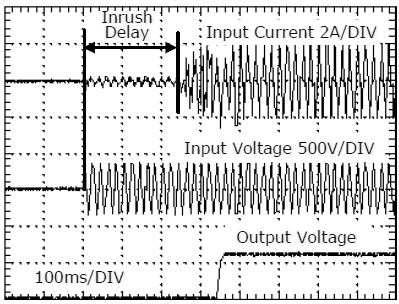Input inrush current
Due to the application of an input voltage to the device, the input and output capacitors are charged, as a result of which a current peak is generated at the device's input. This input inrush current must be limited in order to avoid the undesirable tripping of input circuit breakers or the melting of relay or switching contacts.
The following table provides input inrush current values for various operating conditions.
The charge current of the interference suppression capacitors during the first few microseconds after switching on is not taken into account.
This device is equipped with an electronic input inrush current limiter, which reduces the inrush current peak to a minimum value.
|
| AC 100 V | AC 120 V | AC 230 V |
|
|---|---|---|---|---|---|
Input inrush current | Max. | 5 Apeak | 4 Apeak | 7 Apeak | temperature-independent |
Typ. | 10 Apeak | 10 Apeak | 10 Apeak | temperature-independent | |
Inrush energy | Max. | 4 A²s | 4 A²s | 4 A²s | temperature-independent |
 Fig.4: Typical switch-on behavior at nominal load, 230 Vac input and 25 °C ambient temperature
Fig.4: Typical switch-on behavior at nominal load, 230 Vac input and 25 °C ambient temperature